

for Canto Cumulus 6.6 and Web Publisher Pro (WPP) 3.0 or Internet Client Pro (ICP) 3.0
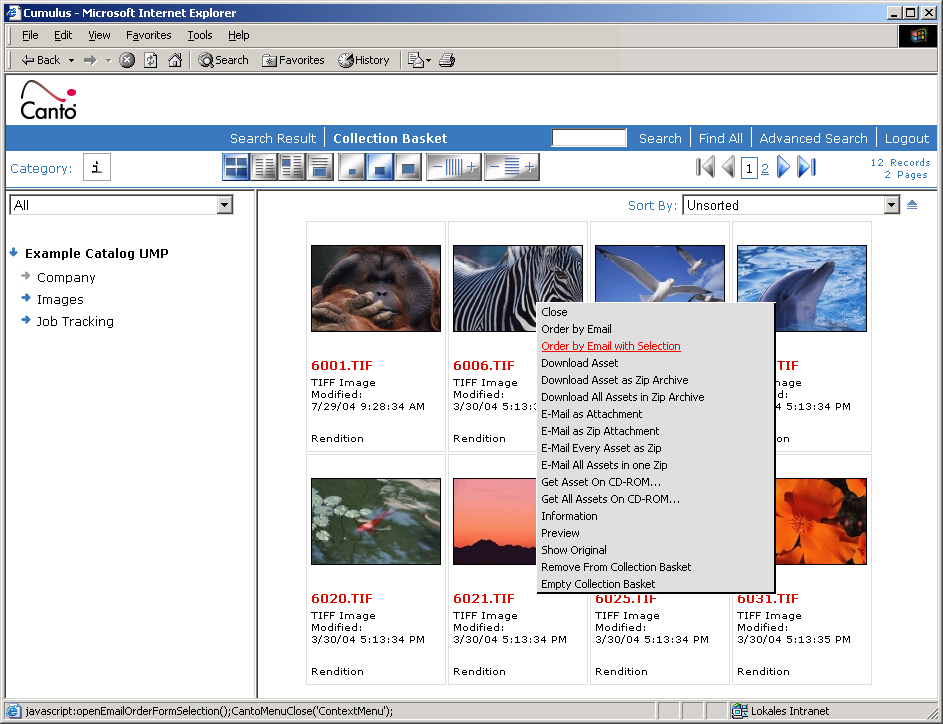
Collect the files in the Cumulus Web Publisher Collection Basket
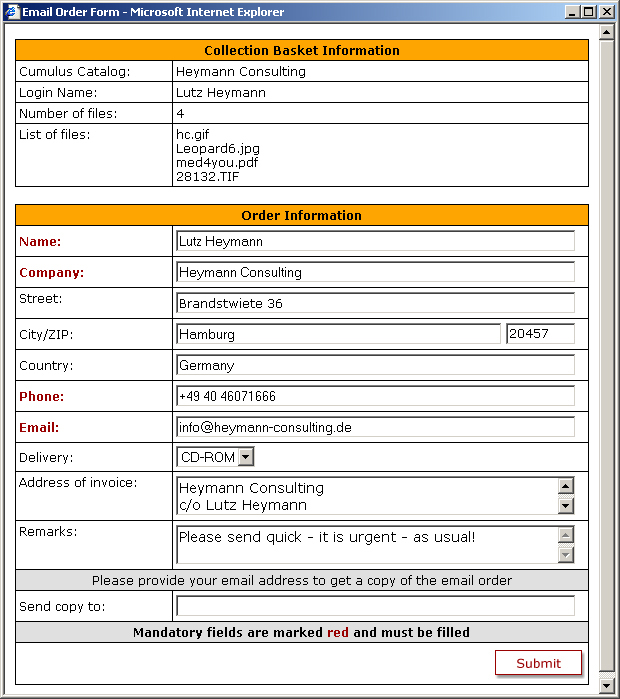
In the standard order form you can email a list of files
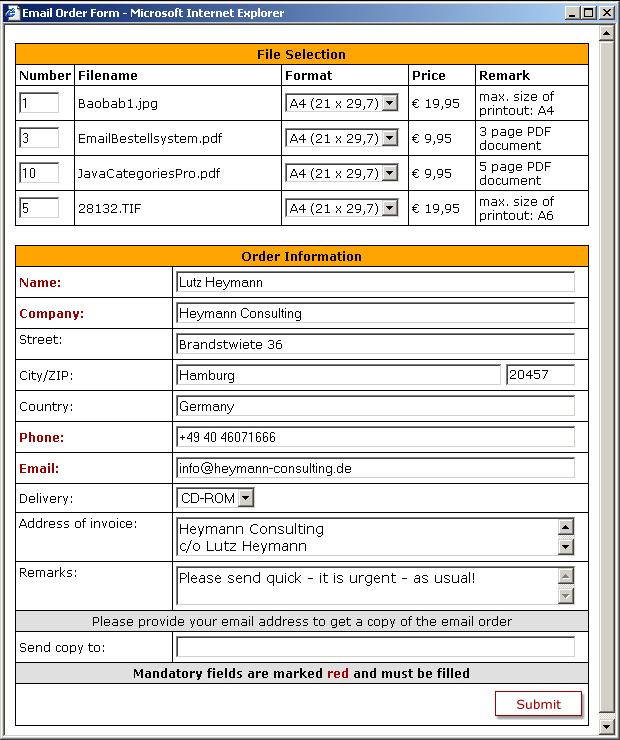
In the extended email form you can also provide the number and format of the ordered files and a new price TAG enables the admin of the website to display price information
Contents The 'Email Order System Pro' is an extension to the Canto Web Publisher Pro (WPP) Option. With the help of this extension the user of the Web Publisher Pro can order files from his service provider by email. An order form will be displayed which can be configured by the administrator of the website. The order form information will be sent to a given email address. For the person who processes the order, the 'Email Order System Pro' comes with two applications for Mac OS and Windows which help to find the ordered files in the Cumulus catalog. The application 'CollectFiles' helps the user to mark the ordered files with a category or text and copy them into a configurable folder. It will also inform about missing files in the catalog The 'Email Order System Pro' comes with two different order forms. The first form is used to send a list of file names in the order email, the second form enables the user to also provide the number of ordered files, the format, the price or additional information. The second order form is used by print service providers. Product Highlights: You will find additional information about the product on our website. The tryout version of the 'Email Order System Pro' is a full version of the product, so you can test all the functionality available. The limitation: the order form will show a demo info and a link to the website. Also the order email shows the demo information. There are no other limitations in the tryout version. The demo version is for testing purposes only and you are not allowed to use it in a working environment! To order the product, send an email to Heymann Consulting. The System Requirements follow the system requirements of the Cumulus Web Publisher Pro 3.0. WebApplication Server: Web Browser ( recommended ): If you are installing the 'Email Order System Pro' for the first time, especially if you are using a demo version of the product, please use this kind of installation. You only have to copy the file 'EmailOrderSystemPro.war' (you will find it inside the 'Web Application' folder) into your Tomcat web application folder ('.../myTomcat/webapps'). The file will be automatically unpacked by a running Tomcat application to a folder 'EmailOrderSystemPro'. Now please configure the following parameters in the configuration file of your web application '.../myTomcat/webapps/EmailOrderSystemPro/WEB-INF/web.xml': After restarting your Tomcat web application server you can access the site via 'http://myServer:8080/EmailOrderSystemPro/' (if your Tomcat is using TCP/IP port 8080 for communication). The pages inside the folder are the files of the current Cumulus Web Publisher Pro with the pages and functions of the 'Email Order System Pro' included. After the standard installation of the 'Cumulus Web Publisher Pro' you will find the web application inside the folder 'Cumulus' inside the folder 'webapps' of your Tomcat application folder. In this folder you will find the folder 'Standard', which is the standard appearance of the 'Web Publisher Pro' (using Java Applet Technology). In this folder you have to make the changes to implement the 'Email Order System Pro': Important remark: When a user accesses the web application, the Cumulus Web Publisher Pro checks the version of the user's web browser. If the web browser is not Internet Explorer version 5 (or higher) or Netscape version 6 (or higher), the user is linked to the folder 'Compatible', which uses a display method without Java Applets. The 'Email Order System Pro' is not implemented in the 'Compatible' directory. The 'Email Order System Pro' comes with an application called 'Collect Files' to find the ordered files in the Cumulus catalog. This application is a Cumulus EJaP (Embedded Java Plugin) based on Canto's EJaP technology introduced with Cumulus 6. In the product folder you will find a folder 'Collect Files' with the module 'CollectFiles.ejp'. Copy this file into the 'ejp' folder in the installation folder of your Cumulus application (Cumulus Client or Single User). Under Windows it is 'C:\Program Files\Canto\Cumulus 6 Workgroup Client\ejp', under Mac OS X it is 'Macintosh HD/Applications/Cumulus 6 Workgroup Client'. The 'ejp' folder of the Cumulus application can be found in the Cumulus package. You can reach this folder by clicking the mouse-button while holding down the CTRL-key on the Cumulus application. Click on 'Show Package Contents' in the context-menu. This will open a finder-window with a subfolder 'Contents'. In that folder you will find a 'MacOS' folder and there you will find the 'ejp' folder in which to copy the 'CollectFiles.ejp' file. Restart the Cumulus application to use the 'Collect Files' application, it will show a new menu item in your Cumulus application called 'Email Order System Pro'.
After the installation of the 'Email Order System Pro' there is a new folder 'EmailOrderSystem' in the folder 'Standard' of your web application. This folder holds the web pages that are displayed when the user accesses the 'Email Order System Pro': After changing the context menu of the WPP Collection Basket as described in the chapter Installation (by replacing the file 'CollBasketContextMenu.jsp'), you can call the email order form by selecting the menu item 'Order by Email'. This is the standard email order form that is shipped with the product: If you want to change the order form, open the file '...myTomcat/webapps/EmailOrderSystemPro/Standard/EmailOrderSystem/EmailOrderForm.jsp' with a text or HTML editor. Please note that one parameter of the order sets the subject of the email. The hidden parameter 'Subject' sets the subject of the email in the file 'EmailOrderForm.jsp' in line 35: The extended email order form comes with fields to specify the number of ordered files and their format. It also contains a price field and a remark field to show the functionality of the TAGs 'getPrice' and 'getFieldValue'. The 'Email Order System Pro' reads the information from the Cumulus catalog record fields 'Price' and 'Remark'. If these fields are not available in your catalog, the fields in the File Selection section of the order form are left empty. You can define mandatory fields in the email form very easily. Mandatory fields start with '_', so just insert this character at the beginning of the field name. The 'Email Order System Pro' will check all mandatory fields before the email is generated. In the example above the field 'Name' is defined as mandatory. The following page is displayed if the user does not fill the field: Please note that the leading '_' is not diplayed in the field name in this error page. Remark: if you change a field name in the order form ('EmailOrderForm.jsp'), you also have to change the name of the field in the email template 'EmailTemplate.txt'. The body of the order email can be configured by using an Email Template file. The software comes with an example Email Template file called 'EmailTemplate.txt'. This is the contents of the example file: You can put this file whereever you want onto your harddisk. You have to specify the location inside the configuration file of your web application 'web.xml' in the parameter 'EmailConfigurationFilePath'. The 'Email Order System Pro' reads the Template file and replaces the field names in brackets ([...]) against their values. Example: [_Name] inside the Template file is replaced against the value of the mandatory field 'Name'. An empty string is inserted if the specified field does not exist inside the order form. The 'Email Order System Pro' also implements two placeholders to insert the date and time into the email.The placeholder for the English date format is [$DATETIME$], the placeholder for the German version is [$DATETIME_D$]. The Selection Area at the end of the Email Template file is used for the second email form (EmailOrderFormSelection.jsp). A lot of parameters are transmitted in this order form. The number of parameters depends on the number of files in the Collection Basket. The Email Template file uses the *-Notation to specify these form parameters. E.g. [a*] stands for all the Asset-Names in the email order form ('a0' to 'an'). The Email Template file seen in the example above creates an email like this: The 'Email Order System Pro' consists of a lot of web pages (in HTML and JSP format) and a TAG library that enhances the functionality of the Cumulus Web Publisher Pro. The Tag library consists of the following TAGs:
2.4 Send Email Order in HTML format The 'Email Order System Pro' sends the order email in a text format. If you want to send the email in HTML format, you can specify the TAG attribute 'contentType' in line 17 of the file './Standard/EmailOrderSystem/SendEmail.jsp'. The software comes with an example Email Template in HTML format. You can find the file in the folder 'Installation' named 'EmailTemplateHTML.txt'. 3 Finding the files in the Cumulus catalog The 'Email Order System Pro' comes with an application called 'CollectFiles' for Mac OS X and Windows which helps to find the ordered files in the Cumulus catalog. This application is based on the Canto EJaP (Embedded Java Plugins) technology introduced by Canto in Cumulus version 6. After installing the EJaP in the Cumulus Client, a new menu item 'Email Order System Pro' is available. With the application 'Collect Files' the user can verify, if all the ordered files are available in the Cumulus catalog. The 'Email Order System Pro' generates an email that holds a list of files with the asset name and the unique RecordID from the Cumulus catalog. The Asset Name is seperated from the RecordID by a semicolon. This is what you have to do to process the order using 'CollectFiles': The frontmost Collection now contains all the found files. You can select all records in the Collection and assign appropriate metadata or copy the assets to a folder to prepare the files for shipment (by using Cumulus functionality). The application 'Collect Files' is an EJaP (Embedded Java Plugin) for the Cumulus Client (Single User) under Windows and Mac OS X: The language of the application 'Collect Files' depends on the current language of the Cumulus Client (English or German). Version 3.0.0 - September 2005 The new version is an implementation of the Email Order System Pro technology for Cumulus 6.6 and the Web Publisher Pro and the Internet Client Pro. Version 2.0.1 - April 2005 The new version supports to send the order email in HTML format. The administrator is able to specify the content type as a mail parameter ('text/html'). Version 2.0 - Dezember 2004 The new version is an implementation for the Cumulus 6 Web Publisher Pro 2.0. The 'EmailOrderSystemPro' web application is an extension to the WPP 2.0 web application shipped with Cumulus 6! It implements a new serial number technology. The serial number is now part of the configuration file 'web.xml'. The software ships with a new 'Collect Files' application based on Canto's EJaP (Embedded Java Plugins) technology introduced with Cumulus 6. The encoding for the email text is now a configurable attribute. Version 1.1 - July 2003 The new version implements a second Email Order Form which enables the user to select the number of ordered files and their format from a selection box. It is also possible to display pricing information direct from the Cumulus catalog fields. Version 1.0.1 - July 2003 An error message was displayed when a user, who logged in as 'guest' (no username and password), tried to send an email order. If the user is logged in as 'guest', now the 'Email Order System Pro' will use the name configured in the attribute 'guestName' of the TAG 'getUserName' for the user name. Please send all your questions about the product to the email address support@heymann-consulting.de. We try hard to answer your questions quickly and improve our products by implementing functionality based on your feedback.
(c) 2003-2005 Heymann Consulting, Media Asset Management Brandstwiete 36, 20457 Hamburg, Germany
0 Introduction

1 Installation
1.1 Simple Installation






In this example the file resides on a Windows Server on the harddisk C:\ and is named 'EmailTemplate.txt'.

1.2 Integration into an existing web application

1.3 Installation 'Collect Files'
2 Configuration
File / Folder
Description
EmailOrderForm.jsp
Implements the first order form which enables the user to send an email containing a list of files. You can define mandatory fields inside the form by using a '_' at the beginning of a field name.
EmailOrderFormSelection.jsp
Implements the second order form which enables the user to send an email containing a list of files, the number of files and format and additional information. You can define mandatory fields inside the form by using a '_' at the beginning of a field name.
SendEmail.jsp
Checks first, if all mandatory field are filled by the user. If one or more mandatory fields are empty, the page 'Error.jsp' is display showing the name(s) of the empty field(s). If all mandatory field have been filled correctly (and the mail parameters are ok) the email is generated and sent.
EmailOK.jsp
This page is displayed after an email has been sent correctly.
Error.jsp
This page is displayed if an error occured while sending the email. Remark: the error message is stored in the implemented Email-Bean in English and German.
Stylesheet.css
The Stylesheet that defines the used fonts, sizes and colors in the 'Email Order System Pro' pages.
pics
Contains the images used for the 'Email Order System Pro'

![]()

2.1 Definition of mandarory fields

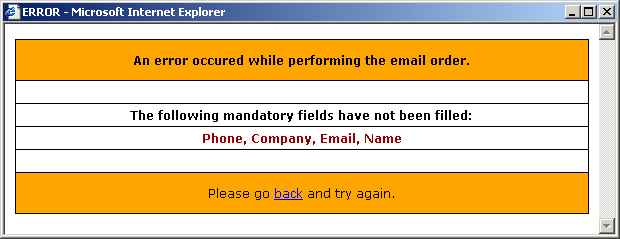
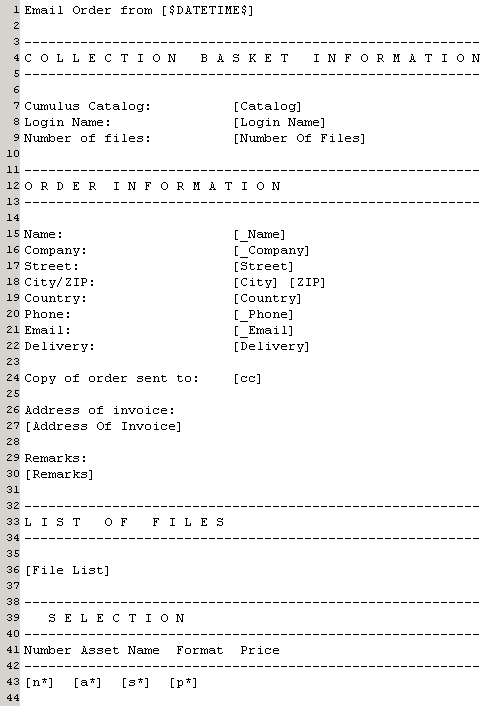
Placeholder
Fieldname
Description
[n*]
n0 ... nn
All field values in the form named 'n0' to 'nn' (Number of ordered files) will be inserted in the email in a new line.
[a*]
a0 ... an
All field values in the form named 'a0' to 'an' (Asset Names) will be inserted in the email in a new line.
[s*]
s0 ... sn
All field values in the form named 's0' to 'sn' (Selection values) will be inserted in the email in a new line.
[p*]
p0 ... pn
All field values in the form named 'p0' to 'pn' (Price) will be inserted in the email in a new line.

2.3 The 'Email Order System Pro' TAG-Library
TAG
Attribute
Description
getCollBasketList
Returns the names of the files in the WPP Collection Basket. The TAG is used for displaying the asset names in the order form and for creating a hidden parameter for the generated email.
fieldNames
List of Cumulus record field names sperated by comma. The TAG gets the field values from the records in the WPP Collection Basket and returns them as a String.
showFieldNames
If 'true', the field name is displayed in front of every field value, seperated by ':'.
fieldDelimiter
The field values are seperated by this delimiter String.
rowDelimiter
The lines are seperated by this delimiter String. If used for display in the page, use '<br>' as the delimiter, if used for providing the list as a parameter for the Email Order System, use '\n'.
debug
If 'true', debug information is displayed in the page.
countCollBasketRecords
Returns the number of records in the WPP Collection Basket
getCatalogNames
Returns the name(s) of the open catalog(s) in the WPP Collection Basket. If there is more than one catalog open, the catalog names in the list are delimited by comma.
ifMandatoryFieldsOK
The body of this TAG is only used if all mandatory fields (field name start with '_') have been filled by the user.
ifNotMandatoryFieldsOK
The body of this TAG is only used if one of the mandatory fields (field name start with '_') has not been filled by the user.
getUserName
Returns the login name of the user.
guestName
Sets the name that is returned when the user is logged in as 'Guest' (no username and password)
sendEmail
Sends the email using the setup STMP server to the given address or creates setup error messages.
listName
Name of the order form field that holds the list of files for the email.
encoding
Name of the encoding used for the email text. Default is 'UTF-8'. The encoding attribute can be changed in the file 'SendEmail.jsp'.
contentType
The attribute specifies the content type of the order email. Default is '' (empty), the email will be sent as a text email. If the email should be sent in HTML format, the atrribute should be 'text/html'.
debug
If 'true', debug information is displayed in the page.
forEveryItemInBasket
The body of this TAG is evaluated n times for every record in the Collection Basket.
getNumberBox
A textbox will be created to specify the number of ordered files for every record in the Collection Basket. The names of the created form fields start with 'n' and are numbered from 0 to n (n = number of records) n0...nn.
getAssetName
Returns the names of the assets for every record in the Collection Basket. The names of the created form fields start with 'a' and are numbered from 0 to n (n = number of records) a0...an.
getSelectionName
Returns the names of the selection form fields for every record in the Collection Basket. The names of the created form fields start with 's' and are numbered from 0 to n (n = number of records) s0...sn.
getFieldValue
Returns the value of the record field given in the attribute 'fieldName' for every record in the Collection Basket.
fieldName
The name of the record field which value should be returned.
getPrice
Returns the value of the record field given in the attribute 'fieldName' for every record in the Collection Basket formatted as a price tag. The values of the field types String, Integer or Double are converted to a currency format with a given comma notation. Please note that the number is truncated(!) after two digits behind the commma.
Example:
Attribute currency: 'US$'
Attribute delimiter: '.'
Attribute delimiter1: ','
Integer: 1234 is displayed as US$ 1,234.-
Double: 1234,5678 is displayed as US$ 1,234.56
A String value will be displayed as given in the field with the currency character in front
The names of the created form fields start with 'p' and are numbered from 0 to n (n = number of records) p0...pn.
fieldName
The name of the record field which value should be returned.
currency
The name of the currency in HTML format which is added in front of the number (e.g. '€' for Euro or '$' for $).
delimiter
"," or "." - delimiter between the Euro/Cents or Dollars/Cents
delimiter1
"," or "." - delimiter at every third position of the number to improve readability
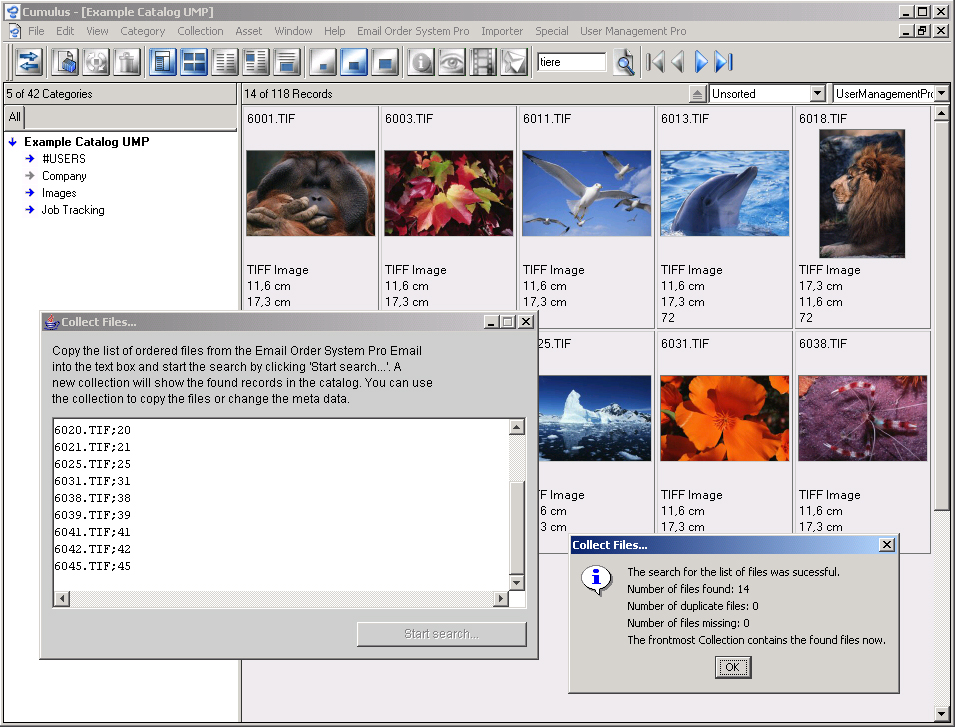

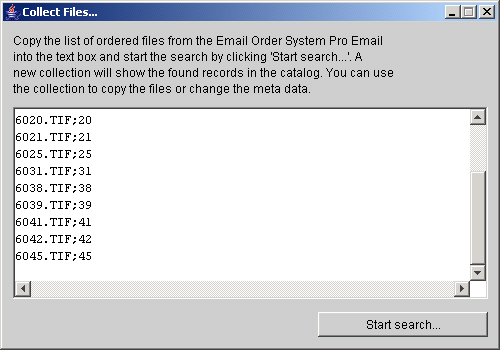



info@heymann-consulting.de, http://www.heymann-consulting.com